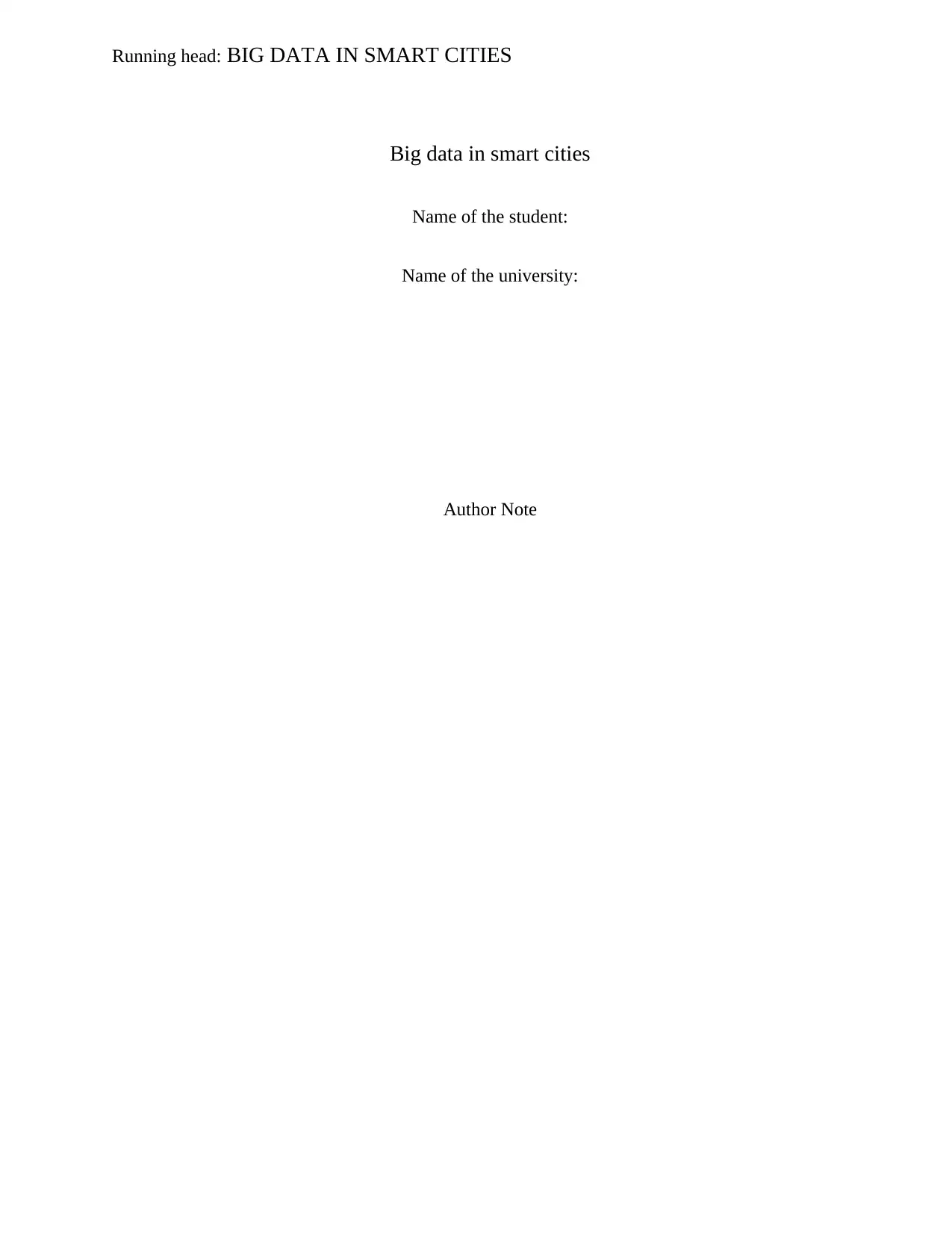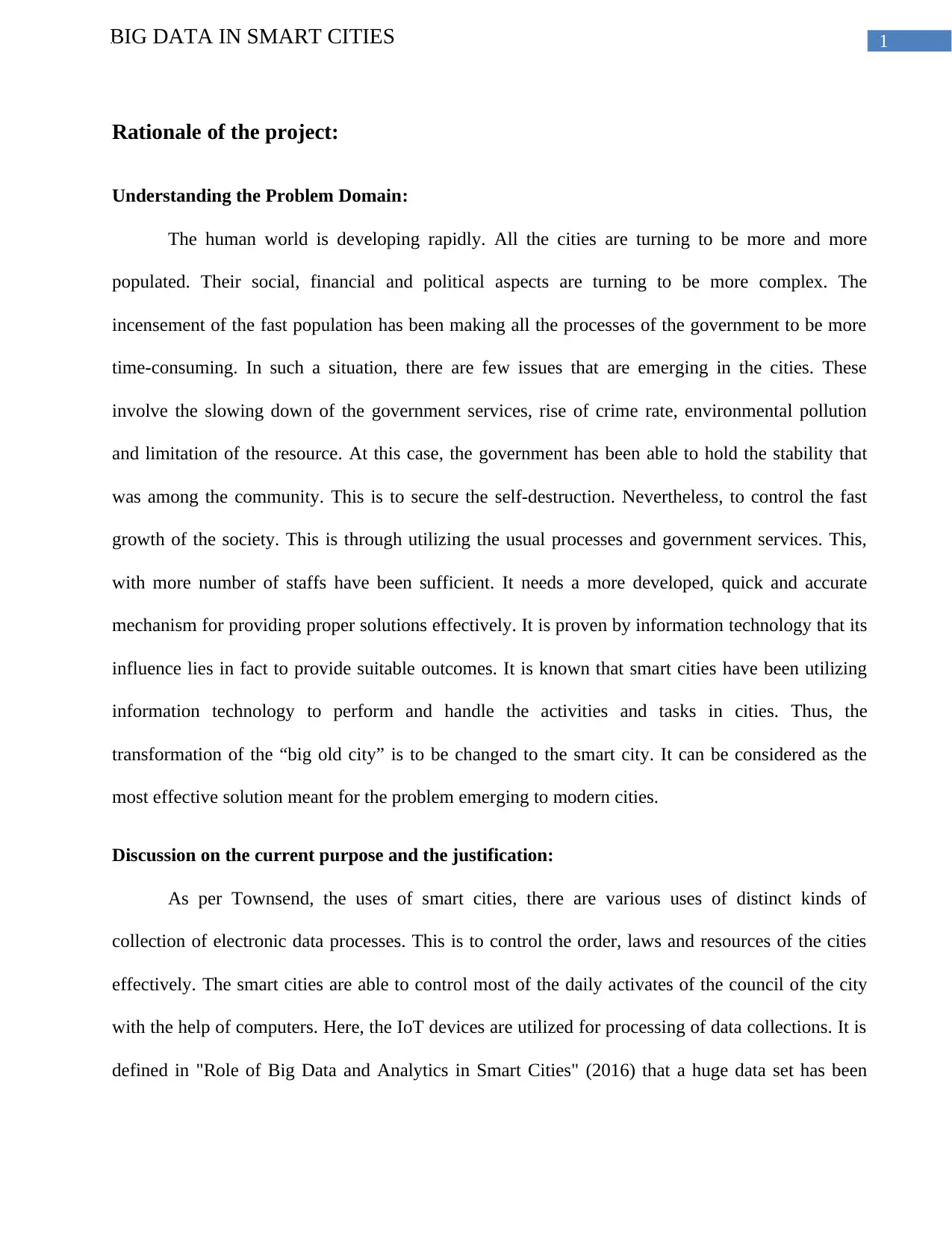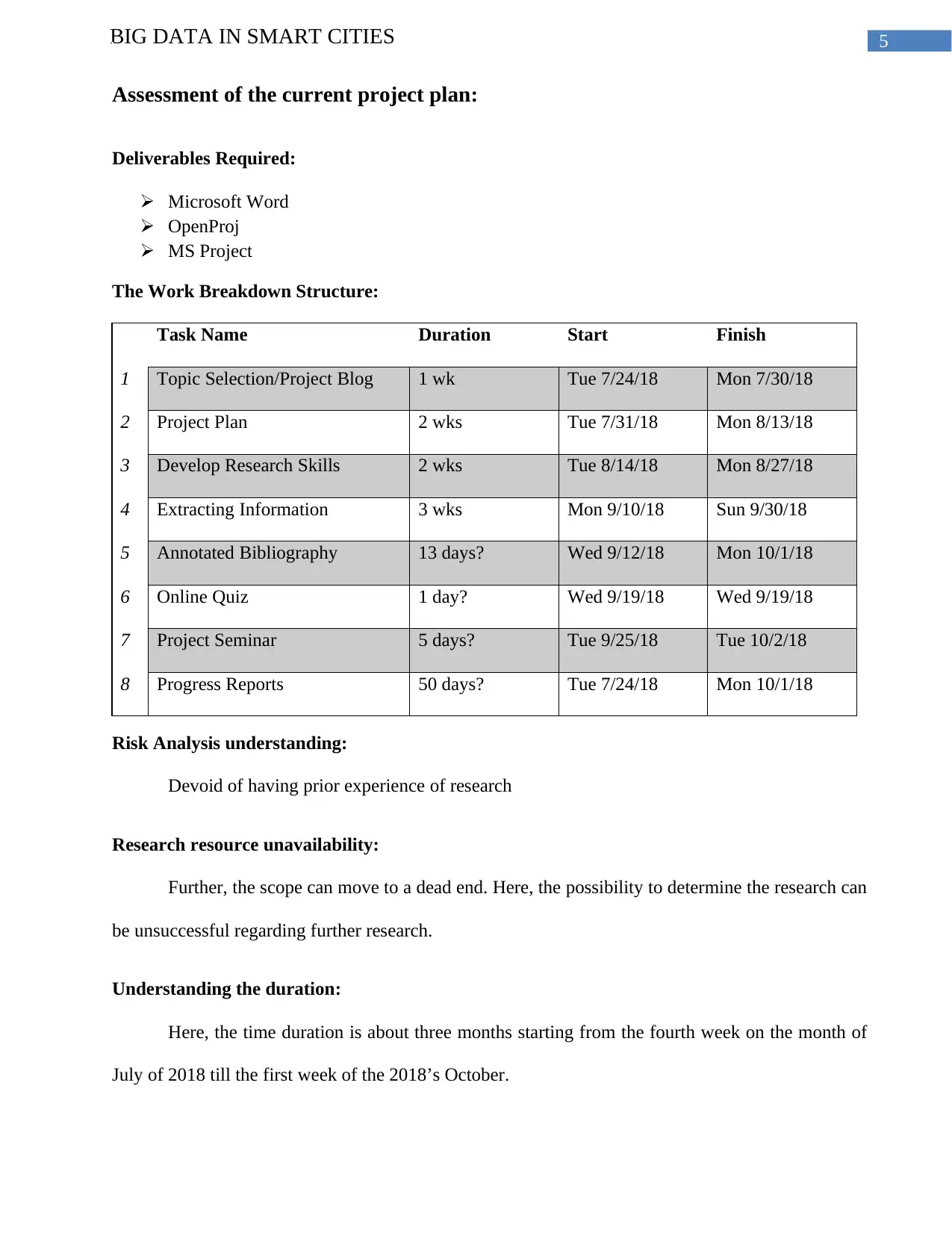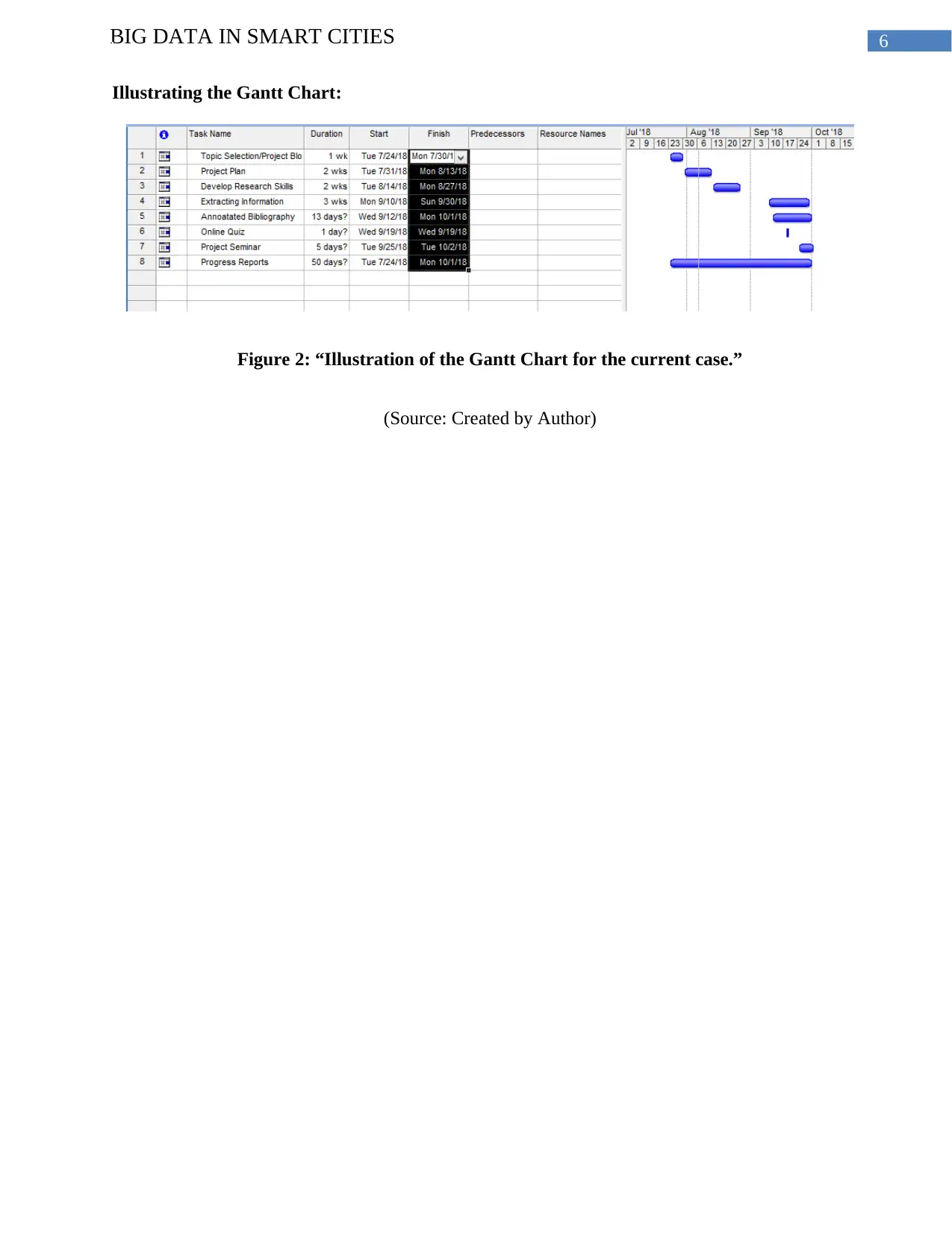Research Project: Big Data and Its Role in Smart Cities
VerifiedAdded on 2022/10/12
|7
|1197
|211
Project
AI Summary
This project report delves into the application of big data within the context of smart cities, addressing the challenges of rapid urbanization and complex societal issues. The project examines how big data and information technology can be utilized to enhance government services, reduce crime rates, and mitigate environmental pollution. The report utilizes a theoretical approach, incorporating inquiry-based learning to analyze the role of IoT devices in data collection and the potential of big data for efficient facility management. It includes a discussion on the research methodology, data analysis techniques, and project planning, including a work breakdown structure, risk analysis, and Gantt chart. The study aims to provide a comprehensive understanding of how big data can contribute to the development and optimization of smart cities, offering potential solutions to emerging urban problems.

Running head: BIG DATA IN SMART CITIES
Big data in smart cities
Name of the student:
Name of the university:
Author Note
Big data in smart cities
Name of the student:
Name of the university:
Author Note
Paraphrase This Document
Need a fresh take? Get an instant paraphrase of this document with our AI Paraphraser

1BIG DATA IN SMART CITIES
Rationale of the project:
Understanding the Problem Domain:
The human world is developing rapidly. All the cities are turning to be more and more
populated. Their social, financial and political aspects are turning to be more complex. The
incensement of the fast population has been making all the processes of the government to be more
time-consuming. In such a situation, there are few issues that are emerging in the cities. These
involve the slowing down of the government services, rise of crime rate, environmental pollution
and limitation of the resource. At this case, the government has been able to hold the stability that
was among the community. This is to secure the self-destruction. Nevertheless, to control the fast
growth of the society. This is through utilizing the usual processes and government services. This,
with more number of staffs have been sufficient. It needs a more developed, quick and accurate
mechanism for providing proper solutions effectively. It is proven by information technology that its
influence lies in fact to provide suitable outcomes. It is known that smart cities have been utilizing
information technology to perform and handle the activities and tasks in cities. Thus, the
transformation of the “big old city” is to be changed to the smart city. It can be considered as the
most effective solution meant for the problem emerging to modern cities.
Discussion on the current purpose and the justification:
As per Townsend, the uses of smart cities, there are various uses of distinct kinds of
collection of electronic data processes. This is to control the order, laws and resources of the cities
effectively. The smart cities are able to control most of the daily activates of the council of the city
with the help of computers. Here, the IoT devices are utilized for processing of data collections. It is
defined in "Role of Big Data and Analytics in Smart Cities" (2016) that a huge data set has been
Rationale of the project:
Understanding the Problem Domain:
The human world is developing rapidly. All the cities are turning to be more and more
populated. Their social, financial and political aspects are turning to be more complex. The
incensement of the fast population has been making all the processes of the government to be more
time-consuming. In such a situation, there are few issues that are emerging in the cities. These
involve the slowing down of the government services, rise of crime rate, environmental pollution
and limitation of the resource. At this case, the government has been able to hold the stability that
was among the community. This is to secure the self-destruction. Nevertheless, to control the fast
growth of the society. This is through utilizing the usual processes and government services. This,
with more number of staffs have been sufficient. It needs a more developed, quick and accurate
mechanism for providing proper solutions effectively. It is proven by information technology that its
influence lies in fact to provide suitable outcomes. It is known that smart cities have been utilizing
information technology to perform and handle the activities and tasks in cities. Thus, the
transformation of the “big old city” is to be changed to the smart city. It can be considered as the
most effective solution meant for the problem emerging to modern cities.
Discussion on the current purpose and the justification:
As per Townsend, the uses of smart cities, there are various uses of distinct kinds of
collection of electronic data processes. This is to control the order, laws and resources of the cities
effectively. The smart cities are able to control most of the daily activates of the council of the city
with the help of computers. Here, the IoT devices are utilized for processing of data collections. It is
defined in "Role of Big Data and Analytics in Smart Cities" (2016) that a huge data set has been

2BIG DATA IN SMART CITIES
assessed to reveal those patterns. It also includes the trends and associations for gaining the solutions
and conclusions for various issues. Moreover, big data has been providing the potential for the cities
in gaining the expensive data that is gathered through IoT devices. Besides, the data can be utilized
to enforce the order and law. This is to develop efficient “facility management services” along with
massive extension of various additional benefits. Though taking into consideration of the
aforementioned realities, the current project undertakes the research on various approaches to do
away with the concerns in smart cities. This is through the bid data by making a discussion on the
deployment of different types of big data into smart cities.
Analysis of the present theoretical and related conceptual framework:
It is discussed by Ram Sharan Mehta (2018), that the theoretical framework reveals the
structure was supporting and holding the research theory. On the other hand, the conceptual
framework makes an analysis of various contexts and variations for the issues and then implement
the best. The current project utilizes the theoretical approach. For providing support to theoretical
framework needed, here, an “inquiry-based learning” has been utilized. This is helpful due to the fact
that the research framework related to the project. Again, as mentioned by Pedaste et al. (2015), this
type of learning delivers the educational strategy. Here, the researchers can flow the practices for
discovering the latest casual relations. Here, the learner can formulate the hypothesis and is able to
test them. This is trough conducting the experiments by undertaking various observations. It is seen
as the approach to resolve the issues, including the skills of problem solving. Here, the inquiry-based
learning comprises of distinct phases and all the phases comprises of various huge groups. These are
been made of various types of smaller sets of different groups. As demonstrated in image below, the
thirty-four inquiry group’s activities are assimilated with greater groups and ultimate to stay with the
common phases.
assessed to reveal those patterns. It also includes the trends and associations for gaining the solutions
and conclusions for various issues. Moreover, big data has been providing the potential for the cities
in gaining the expensive data that is gathered through IoT devices. Besides, the data can be utilized
to enforce the order and law. This is to develop efficient “facility management services” along with
massive extension of various additional benefits. Though taking into consideration of the
aforementioned realities, the current project undertakes the research on various approaches to do
away with the concerns in smart cities. This is through the bid data by making a discussion on the
deployment of different types of big data into smart cities.
Analysis of the present theoretical and related conceptual framework:
It is discussed by Ram Sharan Mehta (2018), that the theoretical framework reveals the
structure was supporting and holding the research theory. On the other hand, the conceptual
framework makes an analysis of various contexts and variations for the issues and then implement
the best. The current project utilizes the theoretical approach. For providing support to theoretical
framework needed, here, an “inquiry-based learning” has been utilized. This is helpful due to the fact
that the research framework related to the project. Again, as mentioned by Pedaste et al. (2015), this
type of learning delivers the educational strategy. Here, the researchers can flow the practices for
discovering the latest casual relations. Here, the learner can formulate the hypothesis and is able to
test them. This is trough conducting the experiments by undertaking various observations. It is seen
as the approach to resolve the issues, including the skills of problem solving. Here, the inquiry-based
learning comprises of distinct phases and all the phases comprises of various huge groups. These are
been made of various types of smaller sets of different groups. As demonstrated in image below, the
thirty-four inquiry group’s activities are assimilated with greater groups and ultimate to stay with the
common phases.
⊘ This is a preview!⊘
Do you want full access?
Subscribe today to unlock all pages.

Trusted by 1+ million students worldwide

3BIG DATA IN SMART CITIES
Figure 1: “The process to merge groups to greater groups to various phases under the inquiry-
based learning”.
(Source: Pedaste et al., 2015)
Figure 1: “The process to merge groups to greater groups to various phases under the inquiry-
based learning”.
(Source: Pedaste et al., 2015)
Paraphrase This Document
Need a fresh take? Get an instant paraphrase of this document with our AI Paraphraser

4BIG DATA IN SMART CITIES
Discussing the required methodology:
Development method of the research and different systems:
It is seen that the qualitative approach concluded to the fact on the basis of non-statistical
processes. Here the qualities have been analyzed. On the other hand, the quantitative approach
derives the result on the basis of results of statistical estimations and mathematical modelling.
Nonetheless, as the project lies on the basis of the theoretical approach, the methodology of
qualitative research is utilized in researching.
Data collection methods or the process of system design:
It is performed as per the literature view.
Understanding Ethical Issues:
This section is not available.
Various requirements of compliances including industry, government regulations or
workplace:
This section is also not available
Discussion on data analysis:
As the project lies on the basis of the theoretical approach, the required qualitative data for
the current case are to be assessed. Here, the qualities are to be investigated rather than the quantities
and additional numerical analysis of the intended information.
Discussing the required methodology:
Development method of the research and different systems:
It is seen that the qualitative approach concluded to the fact on the basis of non-statistical
processes. Here the qualities have been analyzed. On the other hand, the quantitative approach
derives the result on the basis of results of statistical estimations and mathematical modelling.
Nonetheless, as the project lies on the basis of the theoretical approach, the methodology of
qualitative research is utilized in researching.
Data collection methods or the process of system design:
It is performed as per the literature view.
Understanding Ethical Issues:
This section is not available.
Various requirements of compliances including industry, government regulations or
workplace:
This section is also not available
Discussion on data analysis:
As the project lies on the basis of the theoretical approach, the required qualitative data for
the current case are to be assessed. Here, the qualities are to be investigated rather than the quantities
and additional numerical analysis of the intended information.

5BIG DATA IN SMART CITIES
Assessment of the current project plan:
Deliverables Required:
Microsoft Word
OpenProj
MS Project
The Work Breakdown Structure:
Task Name Duration Start Finish
1 Topic Selection/Project Blog 1 wk Tue 7/24/18 Mon 7/30/18
2 Project Plan 2 wks Tue 7/31/18 Mon 8/13/18
3 Develop Research Skills 2 wks Tue 8/14/18 Mon 8/27/18
4 Extracting Information 3 wks Mon 9/10/18 Sun 9/30/18
5 Annotated Bibliography 13 days? Wed 9/12/18 Mon 10/1/18
6 Online Quiz 1 day? Wed 9/19/18 Wed 9/19/18
7 Project Seminar 5 days? Tue 9/25/18 Tue 10/2/18
8 Progress Reports 50 days? Tue 7/24/18 Mon 10/1/18
Risk Analysis understanding:
Devoid of having prior experience of research
Research resource unavailability:
Further, the scope can move to a dead end. Here, the possibility to determine the research can
be unsuccessful regarding further research.
Understanding the duration:
Here, the time duration is about three months starting from the fourth week on the month of
July of 2018 till the first week of the 2018’s October.
Assessment of the current project plan:
Deliverables Required:
Microsoft Word
OpenProj
MS Project
The Work Breakdown Structure:
Task Name Duration Start Finish
1 Topic Selection/Project Blog 1 wk Tue 7/24/18 Mon 7/30/18
2 Project Plan 2 wks Tue 7/31/18 Mon 8/13/18
3 Develop Research Skills 2 wks Tue 8/14/18 Mon 8/27/18
4 Extracting Information 3 wks Mon 9/10/18 Sun 9/30/18
5 Annotated Bibliography 13 days? Wed 9/12/18 Mon 10/1/18
6 Online Quiz 1 day? Wed 9/19/18 Wed 9/19/18
7 Project Seminar 5 days? Tue 9/25/18 Tue 10/2/18
8 Progress Reports 50 days? Tue 7/24/18 Mon 10/1/18
Risk Analysis understanding:
Devoid of having prior experience of research
Research resource unavailability:
Further, the scope can move to a dead end. Here, the possibility to determine the research can
be unsuccessful regarding further research.
Understanding the duration:
Here, the time duration is about three months starting from the fourth week on the month of
July of 2018 till the first week of the 2018’s October.
⊘ This is a preview!⊘
Do you want full access?
Subscribe today to unlock all pages.

Trusted by 1+ million students worldwide

6BIG DATA IN SMART CITIES
Illustrating the Gantt Chart:
Figure 2: “Illustration of the Gantt Chart for the current case.”
(Source: Created by Author)
Illustrating the Gantt Chart:
Figure 2: “Illustration of the Gantt Chart for the current case.”
(Source: Created by Author)
1 out of 7
Related Documents
Your All-in-One AI-Powered Toolkit for Academic Success.
+13062052269
info@desklib.com
Available 24*7 on WhatsApp / Email
![[object Object]](/_next/static/media/star-bottom.7253800d.svg)
Unlock your academic potential
Copyright © 2020–2025 A2Z Services. All Rights Reserved. Developed and managed by ZUCOL.



